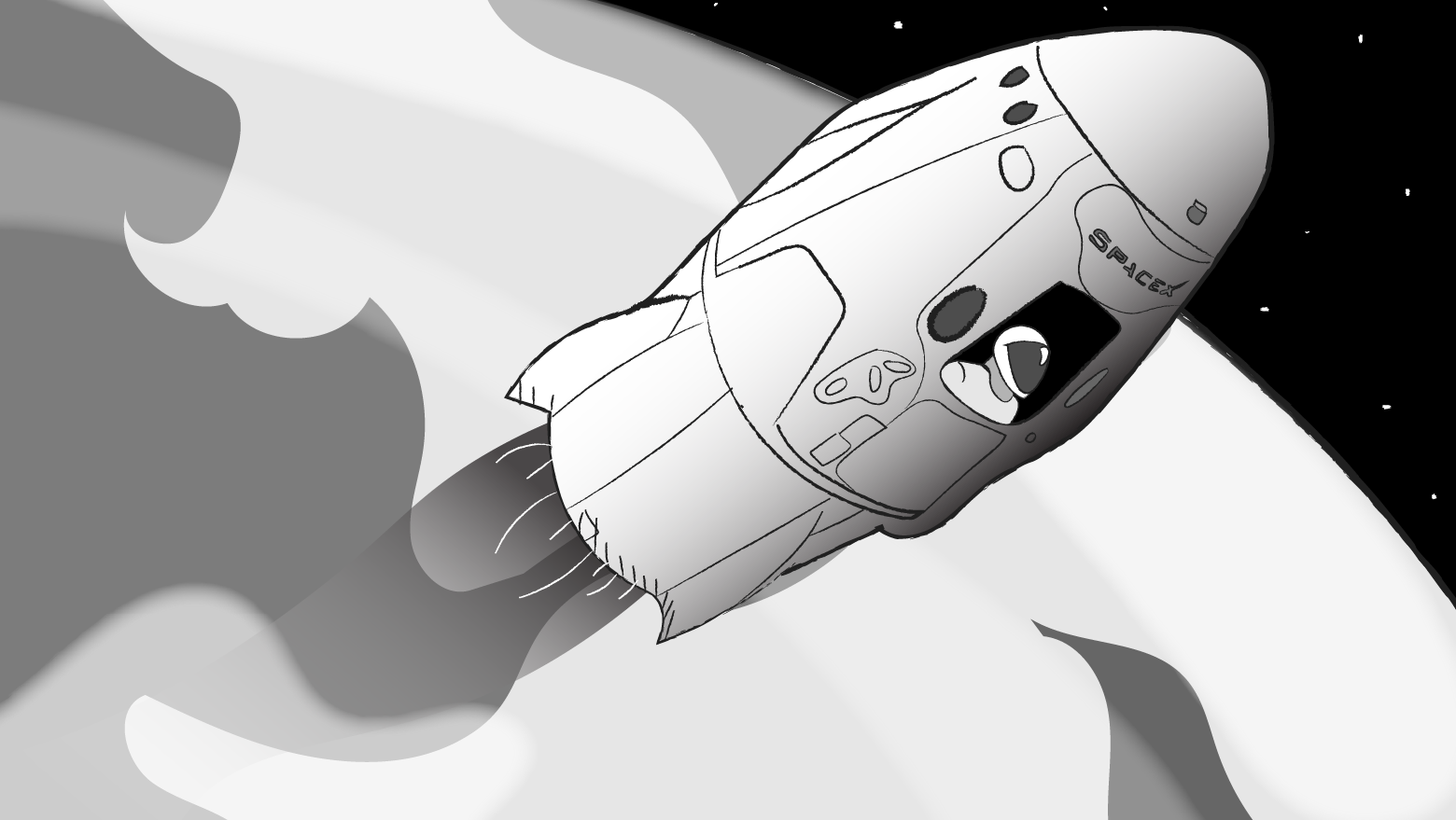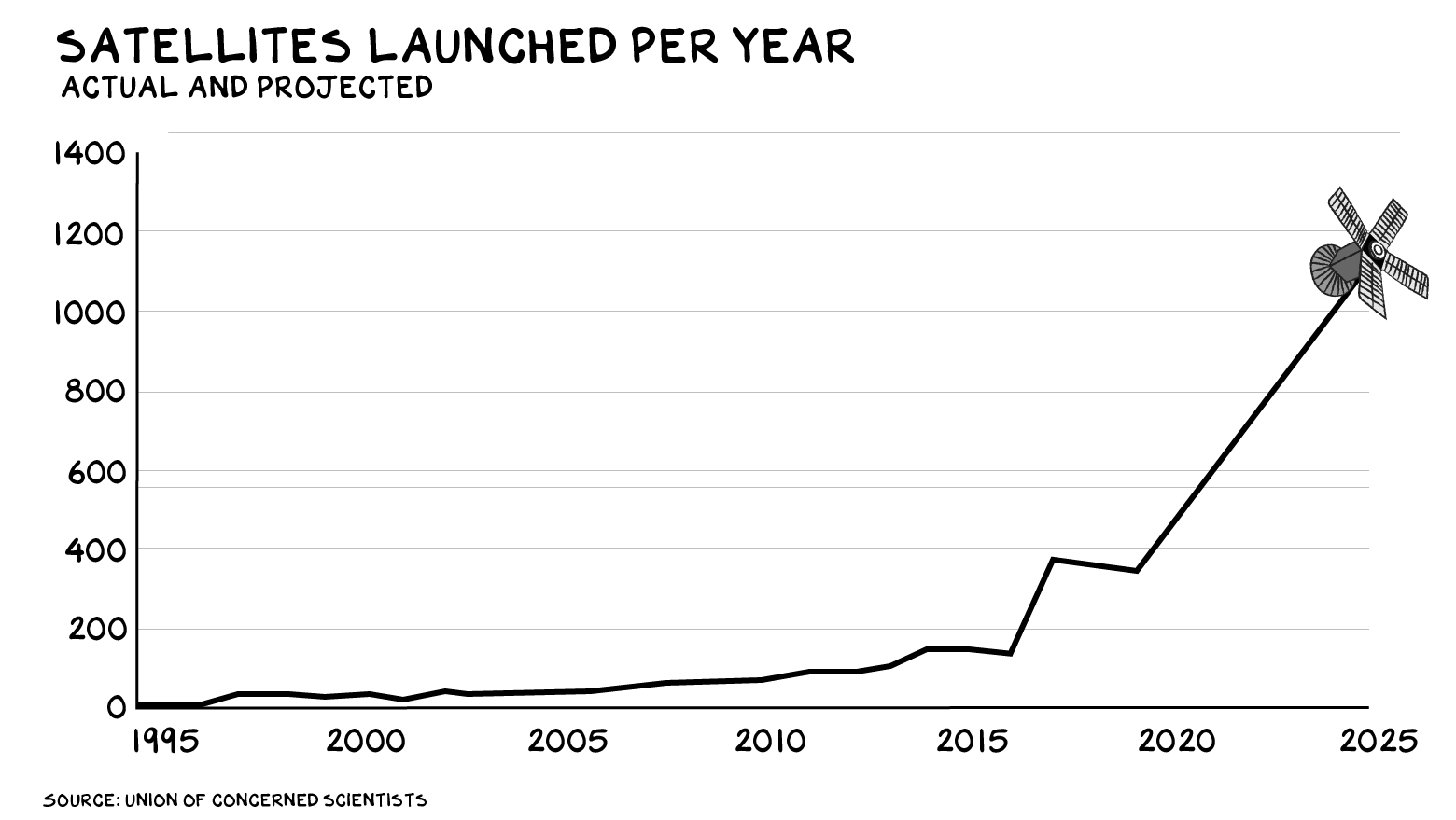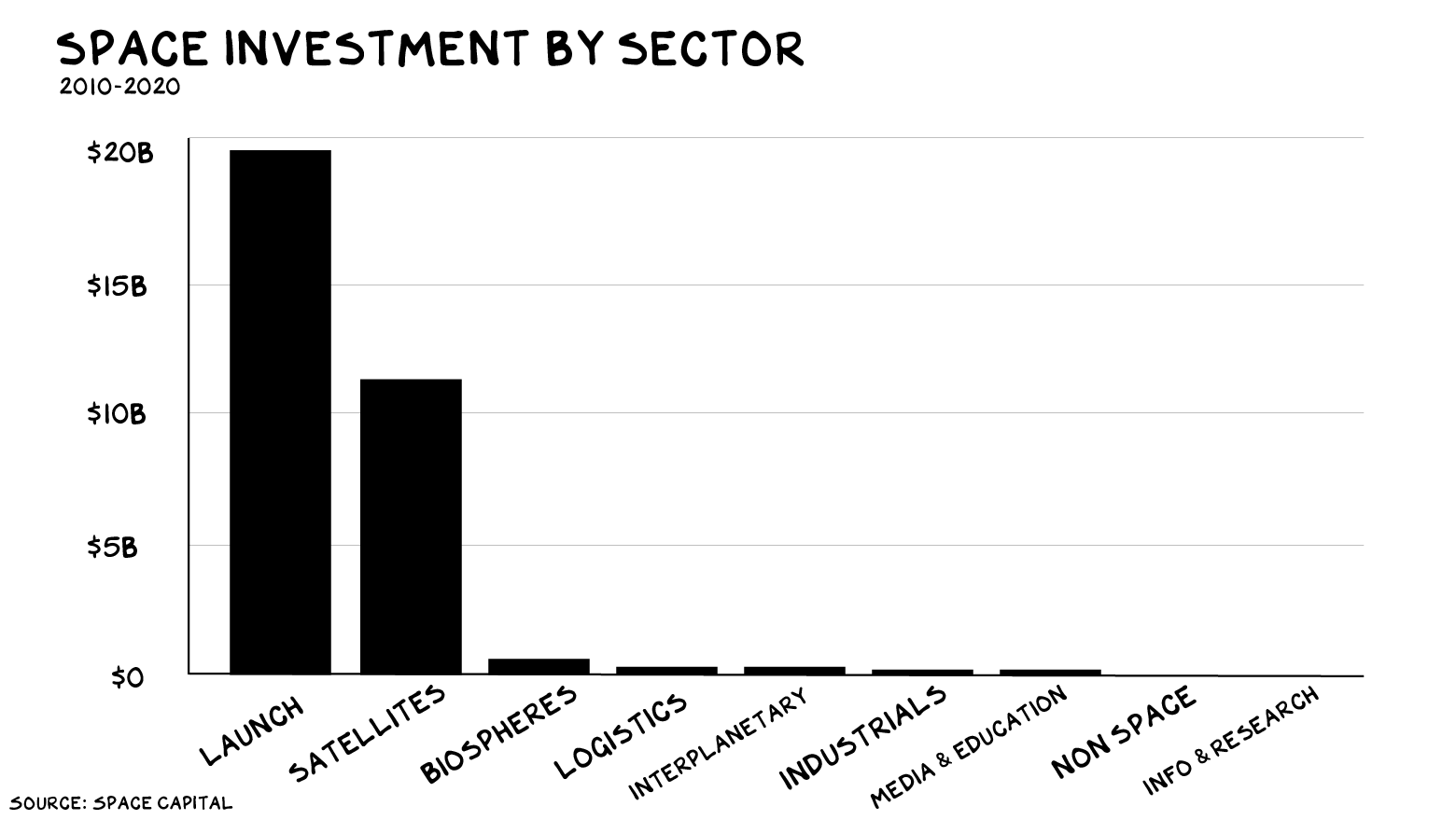SPAC(e)
Courtesy of Scott Galloway, No Mercy/No Malice, @profgalloway
People worried about starving or being eaten don’t have time to ponder the finite nature of life. But once we know we’re going to survive in the short-term, immortality begins to loom larger than mortality. Affairs, Teslas, and ayahuasca are the accessories of a life with more money than time. Now the billionaire class has taken midlife crises to a new level. In the past month, French billionaires alone have cut ribbons on: a $194 million art museum in Paris; a $175 million Frank Gehry-designed “creative campus” in Arles; and a nearly $900 million, 16-year renovation of La Samaritaine department store, complete with hotel, spa, and wavy glass facade.
We do things bigger here in Texas, though.
Last month, Jeff Bezos announced he would be aboard Blue Origin’s first manned space flight, scheduled for July 20. A recently divorced billionaire on human growth hormone transported into space in a giant dildo powered by an oxygen-rich rocket engine that produces 490 kilonewtons of thrust is ground zero for everything that is right and wrong with society. Mostly the latter. But I digress.
Not to be outdone in the big bank/little dick department, Richard Branson is rumored to be seeking to beat Bezos into space. He might get suborbital before Bezos, but he’s hardly breaking new ground. At least 570 people have sojourned in space since Yuri Gagarin made the first trip in 1961. Branson wouldn’t even be the oldest person to do it: John Glenn left the planet at 77 years old (his second trip).
The Final Frontier
The desire to bravely go where no one has gone before is deeply rooted in the human spirit. Discovery must be a feeling of great wonder. At that moment, you are here for a reason. You are immortal.

Exploration can be hugely beneficial for those who follow, who get to cross Donner Pass on pavement. Yet nearly 50 years since the Apollo astronauts last walked on the moon, we’ve … not been back. Space is not the Sierra Nevada.
Space is exponentially more expensive and dangerous. Nineteen of the 570 people who’ve ventured into space haven’t returned, yielding a mortality rate of 3.3%, vs. 1.3% for climbing Everest and .04% for base jumping. Worse, by American standards, space travel is going to be a shitty business.
Even with our advanced technology, and a fawning CNBC engaging in a consensual hallucination that these billion-dollar hair plugs are for all mankind, the ROI is suspect. That last sentence is my way of saying “makes no fucking sense whatsoever.” There is 100x the return investing in technologies and systems of cooperation on a planet already perfect for human life, a mere 38.6 million miles from Mars. The billionaire obsession with space fantasy (and our willingness to go along with it) isn’t just disappointing, it’s nihilistic. Our idolatry of innovators is morphing into phantasmagoria.
More Space
There are four reasons to put a rocket into space. In order of near-to-medium-term relevance (i.e. having any purpose this century), they are:
- Hauling stuff
- Scientific exploration
- Tourism
- Colonization
Hauling
There’s a real business in hauling stuff — mostly communications satellites — into orbit. Indeed, this is where both Bezos and Musk have placed their bets. Blue Origin and SpaceX are serious space-hauling companies. Apparently, it’s also a profitable business. Says Blue Origin CEO Bob Smith: “We make money on every flight.”
Scientific Exploration
Scientific exploration is worthwhile, but it’s not a business. It feeds businesses (hauling, materials, communications), but this is deep science, better pursued by our commonly owned enterprise, the government.
In fact, contracting is becoming a competence for NASA. In 2010 commercial launches represented about 30% of all U.S. launches. Last year, they accounted for 80%. Private enterprise is eliminating NASA’s need to design, build, and launch. That’s a good thing: It means they have more time to focus on exploring. Let capitalism handle the picks and shovels. NASA will handle the science.
Tourism
After that, we venture into ego and fantasy. Space tourism is a bad business that could end in a flash … literally. What’s the market for people willing to spend $250,000 to be weightless for a few minutes? What’s the repeat market? And what will be left of that market after the first tourist rocket explodes on the launch pad, killing Bob from accounting? Because the nature of rockets is … they explode. About 90% of U.S. rocket launches were successful last year. That might sound OK until you start putting humans in them.
In human transport, superior shareholder returns will be a function of fast vs. far. In my view, the most under- and overhyped transportation firms are Boom Technologies and Virgin Galactic, respectively. The market for people willing to pay $25,000 to get from NYC to London in 3.5 hours is (at a minimum) 1000x the market for people willing to pay $250,000 for a 90-minute suborbital ride to the Kármán line. Six hundred people have paid $250,000 to reserve a seat on Virgin Galactic. Six hundred people land on a private jet at Teterboro every 6 hours.
Colonization
As for colonization of Mars … really? The only interesting question is whether Elon actually believes any of this — whether anyone at SpaceX believes any of this — or whether it’s purely a PR stunt. Colonizing the Red Planet will not happen in my (or my kids’) lifetime. Intense solar radiation, combined with the lack of atmosphere and low gravity, would require living (dying) quarters buried deep under the planet’s surface for any hope of survival. As astronomer Caleb Scharf told us on Pivot, “there’s a lot of stuff [on Mars] that wants to kill you.” The worst place on Earth is better than the best place on Mars.
The SPAC(e) Race
The biggest trend in space over my lifetime has been the rise of the private space hauler. Who’s best positioned to win in this new market? In general, there are three ways to maximize profits: reduce costs, do more (in this case, more flights), and diversify your business.
The Big Three — Blue Origin, SpaceX, and Virgin Galactic — are all making headway on #1. All have invested in reusable rockets, which have reduced launch costs by 70%. On #2, we have a clear leader: SpaceX has launched almost three-quarters of this year’s U.S. flights.
As for #3, Virgin Galactic is the clear loser, as Richard Branson is focused on space tourism. Jeff and Elon, by contrast, are investing heavily in orbital infrastructure. Between them, SpaceX’s Starlink project and Amazon’s Project Kuiper plan to launch nearly 14,000 satellites, providing continuous, high-speed Internet access globally. That should keep the space haulers busy for some time.

In sum, there’s real money to be made in hauling stuff — but satellites, not tourists. The past decade has seen more than $125 billion of investment poured into positioning, navigation, and timing (PNT), a sector that relies on good satellite constellations to feed Uber, Maps, DoorDash, and nearly every other app on your phone. This is why launch vehicles and satellites are hogging all the space infrastructure investment.

With 1,480 unique space companies competing for a place in the stars, the space economy is very thirsty. But a rocket needs more fuel than a Ford F150 — about 12,300x more. What do you do when you need fuel (capital) in exuberant excess? You either 1) find a billionaire or 2) access the public markets.
SpaceX, Blue Origin, and Virgin Galactic all have a massive head start because they were birthed by billionaires. Musk, Bezos, and Branson will pay their kids’ expenses no matter how dysfunctional or explosive. But the sector is attracting new sources of capital.
Take Rocket Lab, a 500-employee startup that also launches rockets. How will it get the capital it needs to keep up with the 9,500-employee behemoth that is SpaceX? Via SPAC. In March, Rocket Lab merged with Vector Acquisition Corp. and raised $750 million at a $4.1 billion valuation. The company has already had two successful launches this year.
A dozen other space startups have also gone (or are going) public via SPAC. Astra, a small satellite-launching company, raised $500 million at a $2.1 billion valuation. Spire Global, a satellite-data company, raised $475 million at a $1.6 billion valuation. There are hundreds of other space startups thirsty for an injection of public cash. The 2021 SPAC boom is yielding tremendous opportunity and risk for astronauts and investors.
Near vs. Deep Space
My observation is that men are more focused on deep space, and women near space. Men are more ego driven and obsess about frontiers in business and the solar system. Women are (cue the Twitter hate) more concerned with exploring things near them, finding less reward in being the first person on Ganymede. My advice to young men, especially those with kids, is to be more focused on near space. As you get to the end of your time on the third rock from the sun, you won’t be desperate to spend more time with strangers, but the people closest to you. I spent the first 40 years of my life obsessed with getting affirmation from people I didn’t know. It came at a cost to relationships with my family, friends, and ex-wife.
Tonight the family ate at a sushi restaurant, and my 10-year-old ordered kakigori, Japan’s quintessential summer treat: shaved or crushed ice drizzled with flavored syrup or condensed milk. It’s awesome. Nobody, despite my son’s urging, would try it. I agreed and demonstrated a rare expression of joy (see above: It is awesome). My son, at that moment, felt so close to me he pushed the kakigori in front of me and sat on my lap so we could enjoy the dessert together. It felt as if I was discovering something nobody had ever felt/seen before, and all of mankind would benefit.
I am strong, here for a reason … immortal. Going where (this) man has never gone before.
Life is so rich,

P.S. Bold decisions like navigating space and exploring new frontiers require reams of data and sound strategic analysis. Section4, my startup, gives students the tools to tackle today’s critical business decisions — whether in space or on Earth. Our newest two-week course (we call them Sprints) will level up your data & analytics game. It’s taught by Tom Davenport, one of the best and brightest in his field. Sign up for early access.



